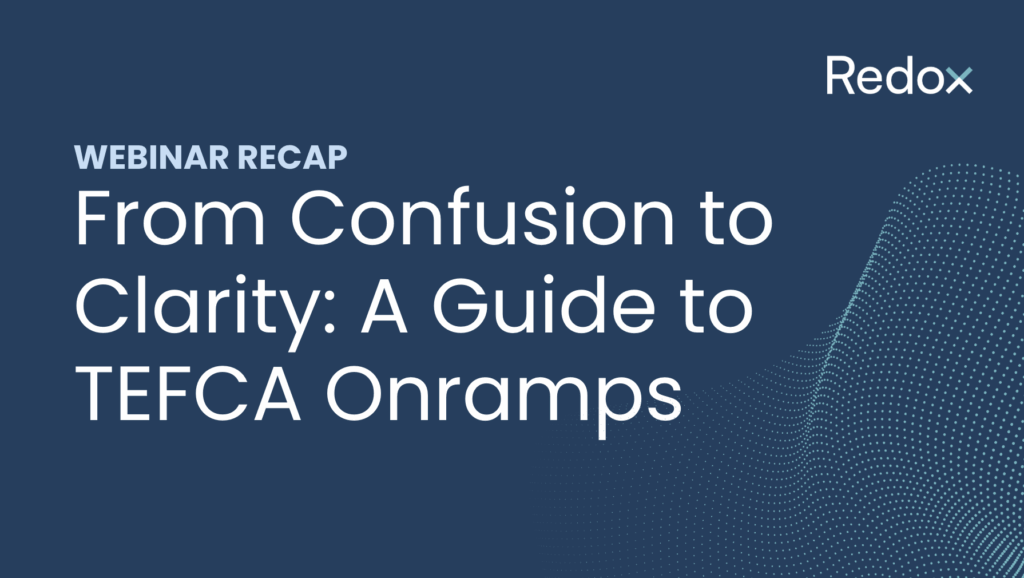TEFCA is here, and it’s evolving fast. But for many healthcare organizations, the path to participation still feels unclear. That’s why we hosted a live session with experts Gail Hamilton (Product Manager overseeing FHIR integrations and Networks at Redox) and Steve Seydel (Senior Manager of Enterprise Implementation at Redox) to break it all down.
In this recap, we’ll share key takeaways from the conversation, quick clips you can revisit, and practical guidance for getting started with TEFCA (without getting lost in the acronym soup!)
Setting the Stage: Why TEFCA, Why Now?
“We’re all here today to discuss a promise: the right data, about the right patient, at the right time.”
TEFCA (Trusted Exchange Framework and Common Agreement) is the federal initiative aiming to standardize health data exchange across the entire care continuum—from providers and payers to public health agencies and individual patients.
This session opened with a shared truth: TEFCA isn’t just about compliance. It’s about unlocking modern, patient-centered interoperability at scale. But getting there requires understanding how TEFCA is structured and where your organization fits in.
The TEFCA Ecosystem
Gail broke down the core players:
- RCE (Recognized Coordinating Entity): Currently Sequoia, responsible for governance and specs
- QHINs (Qualified Health Information Networks): The backbone for routing data
- Participants & Sub-participants: Providers, payers, vendors, and others exchanging data
- Implementers (like Redox): Technical infrastructure + advisory partners to help you connect and evolve with TEFCA
Four Key Pillars That Set TEFCA Apart
Steve outlined what makes TEFCA different from legacy networks:
- Built on proven networks – not a start-from-scratch effort
- Expands beyond treatment – supporting multiple exchange purposes like public health, benefits, and individual access
- Broadens participation – enabling payers, patients, and other stakeholders to have better access to and control of data
- Modernizes exchange – supporting FHIR APIs and dynamic registration (versus just document-based CCDs)
How FHIR Changes the Game
FHIR-based exchange is the future, and TEFCA is on a roadmap to get there. Dynamic registration and support for real-time, purpose-specific data access (versus all-or-nothing CCD downloads) are on the horizon.
Key benefits:
-
Targeted data retrieval (e.g. just allergies)
-
Reduced technical burden on participants
-
Real-time interoperability at scale
Choosing Your Path to Connect
There are multiple ways to participate in TEFCA, and the right path depends on your organization’s needs, resources, and exchange goals. You can:
- Connect directly to a QHIN, handling technical onboarding and policy alignment on your own, but with a direct conduit to the QHIN.
- Work with an implementer or onramp to connect to a QHIN, which can alleviate technical burden, but adds an additional partner into the mix.
Onramps like Redox can help organizations move fast, avoiding complex technical infrastructure builds and allowing IT teams to focus on data exchange.
Real-World Momentum
- Epic is migrating all customers to TEFCA by end of 2025 via its own QHIN (and other EHRs are following suit)
- Over 9,200 organizations and 47,000+ endpoints are already connected (data pulled on 9/27/25; see the most recent figures here)
- Individual Access and expanded Exchange Purposes are making patient-centric interoperability a reality
The Bottom Line: The time is now to start with TEFCA
Whether you’re a health system or vendor, the path to TEFCA readiness starts with a strategy. Don’t wait for mandates to hit; momentum is building fast.
Redox is here to help. With a production-ready environment and expertise to guide you through the complexity, we make it faster (and easier) to get connected to TEFCA. Get in touch to get started.

